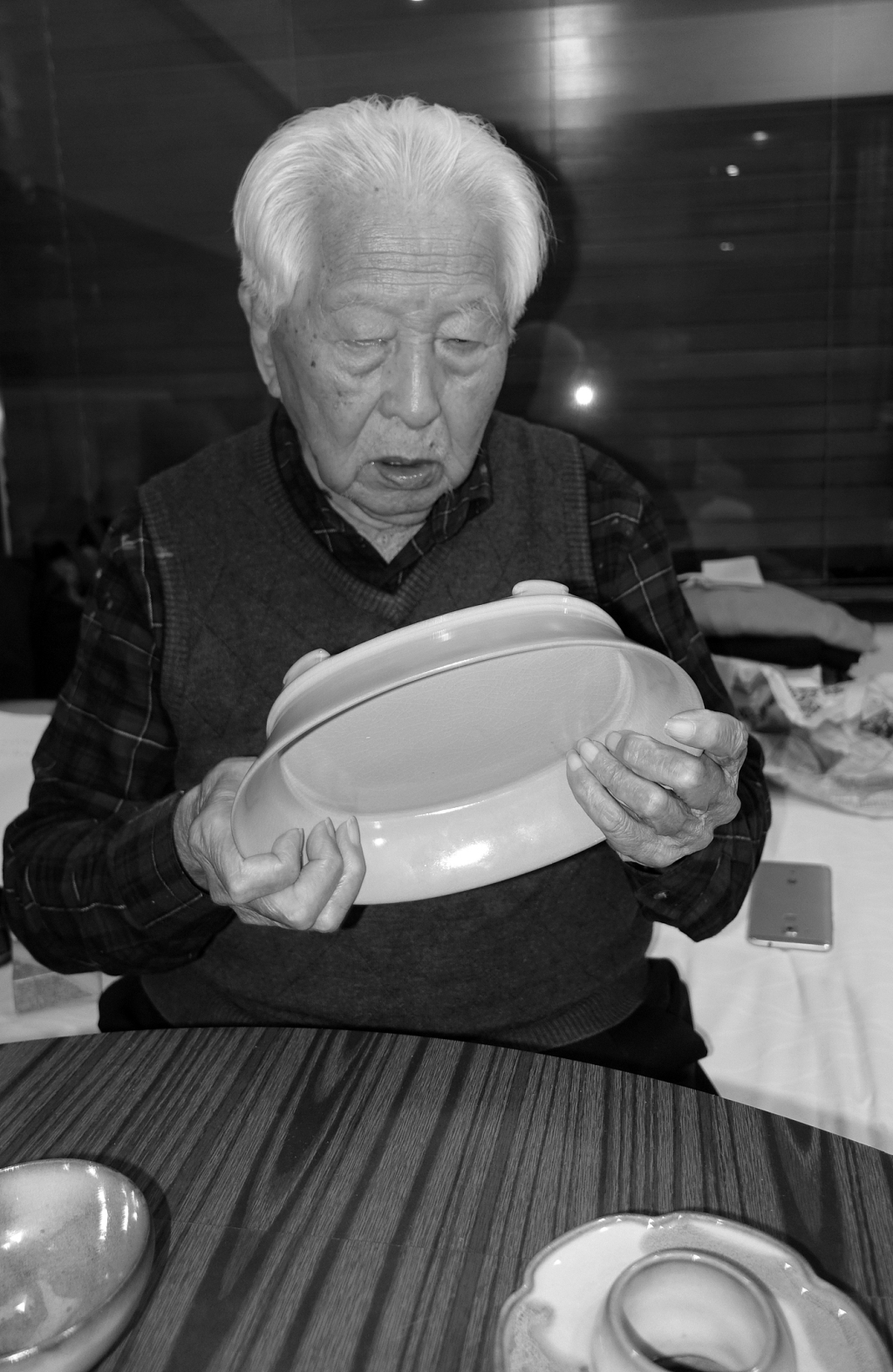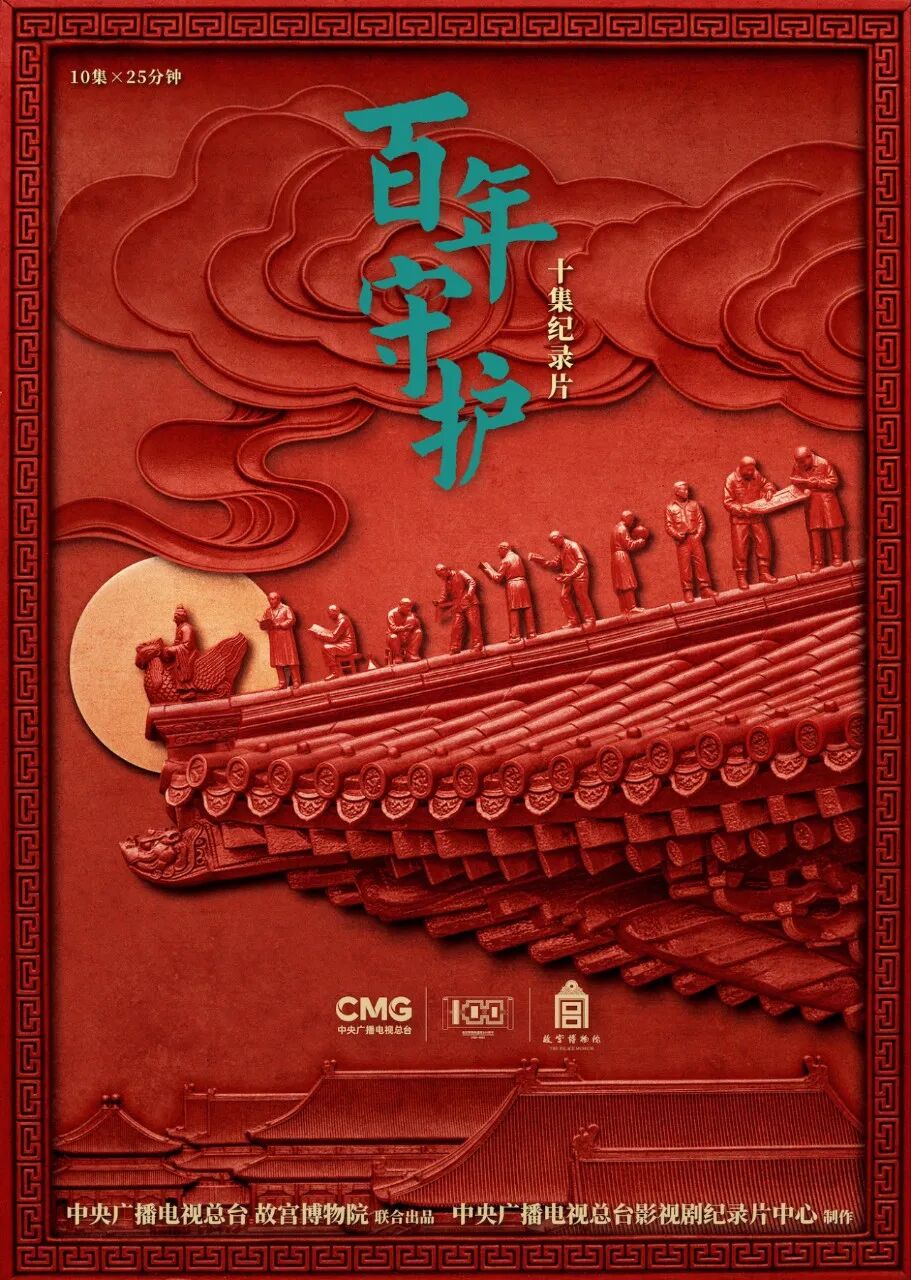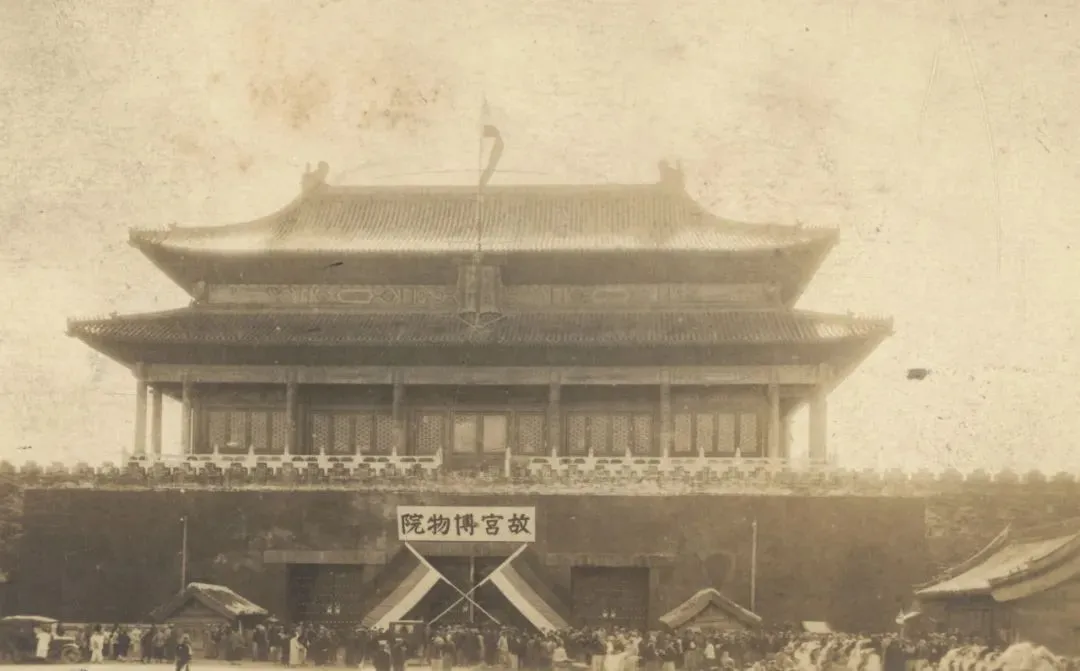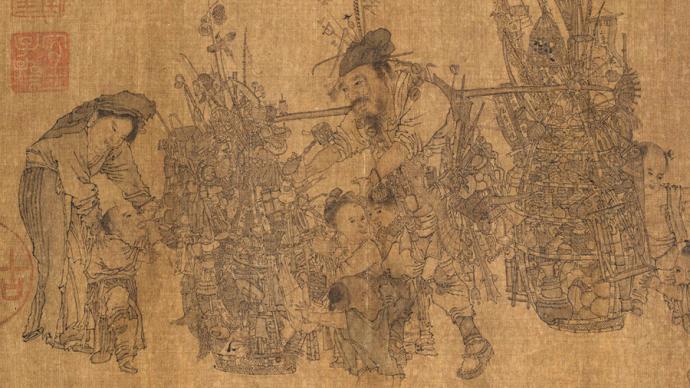
In ancient Chinese figure paintings, there are not only Han Chun and virtuousness expressing the "temple and ceremonial style", but also high-flying and graceful tours of "the elegance of the forest".
On August 30, "All Living Beings - Special Exhibition of Figure Paintings in the Palace Museum's Collection of Past Dynasties (Phase 3)" will be exhibited at the Palace Museum's Wenhuadian Painting and Calligraphy Museum. This exhibition is the third phase of the special exhibition of figure paintings of past dynasties collected by the Palace Museum. Xia Gui's "Grazing in Snow Stream" and Li Song's "Soldier", which are collected by the Palace Museum, are selected.
A total of 96 paintings of figures and genres of past dynasties are displayed. The gestures, frowns and smiles of the characters in the masterpieces all present vivid and colorful images of sentient beings and scenes of ancient life. 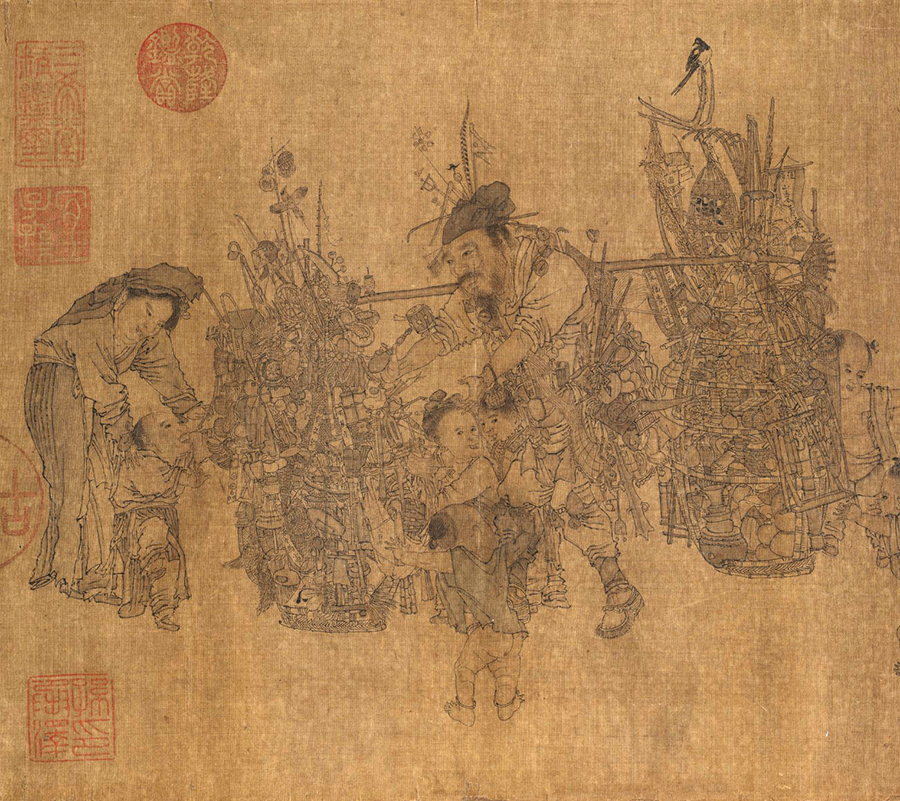
Southern Song Dynasty Li Song's "Trademan" volume (detail)
Ancient rock paintings already have the prototype of figure genre paintings. Since the Western Zhou Dynasty, a political tradition of observing customs and changing customs has become a political tradition, which makes the rulers of the past dynasties pay more attention to the changes of folk customs. The innocence of the world, the humanities of special places, the artificiality of farmers and workers, and the transactions of merchants can all be conveyed by the intuitiveness and artistry of pictures. Coupled with the artist's conscious care and record of people's lives, figure genre painting has gradually become an important painting subject. During the Wei and Jin Dynasties, there were famous painters of Tianjia scenery. In the Song Dynasty, the figures and genre paintings reached their peak, with diverse techniques and a wide range of subjects, such as farming, mulberry, fishing and hunting, cultivating and textiles, moon and social celebrations, games in villages and cities, and travel of merchants. endless. 
Five Dynasties Hu Gong (biography) "Zhuo Xie Tu" volume (detail)
Genre paintings have unique artistic, historical and academic value. The emphasis of genre painting itself has surpassed the figure schema, and the humanistic connotation and humanistic care conveyed by specific scenes and figures are the meaning outside the painting of figure genre painting. Although genre paintings have various themes, from a general point of view, they mainly focus on festive themes, showing the prosperity of the people and the prosperity of the country and their lives and work in peace and prosperity. Due to the different vision and angle of the painters, as well as the identity of the painters themselves, out of the painters' conscious awareness and care, their brushes will also show the difficulties of people's livelihood. When appreciating and interpreting genre paintings, we might as well try to capture the true emotions that the painter most wanted to express, and appreciate the warmth and wisdom in the ordinary life of the ancients. 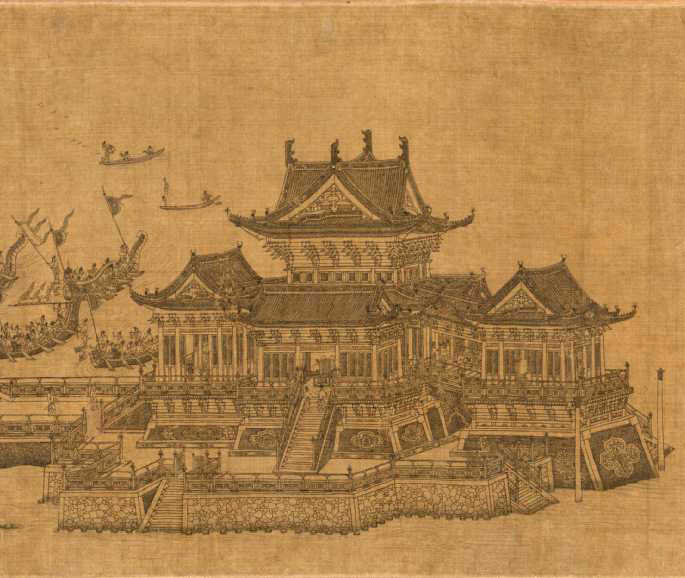
Yuan Ren's "Dragon Boat Victory" Volume (Part)
In conjunction with the third phase of the "Special Exhibition of Figure Paintings Collected by the Palace Museum", the Palace Museum Publishing House published the accompanying exhibition catalogue of "All Beings and Various Forms", and arranged the works into the collection according to the content of the exhibition, fully showing the style of the exhibition. "All Beings and Various Forms" includes 105 paintings, including the five-dynasty Hu Gun (biography) "Zhuo Xie Tu" volume, the Northern Song Dynasty Wang Juzheng (biography) "Spinning Wheel Picture" volume, the Southern Song Dynasty Ma Hezhi (biography) "Binfeng Tu" volume, Southern Song Dynasty Xia Gui's "Snow Stream Grazing", the Southern Song Dynasty Li Song's "The Merchant", the Southern Song "Hundred Sons in the Spring" page, the Southern Song Liu Luzhong's "Tian Fan Drunk Returning", the Yuan Dynasty's "Dragon Boat Winning the Tender" volume, the Southern Song Dynasty "Spring Tour Evening Return" page, Ming Dynasty Zhou Chen's "Xia Qi Shi Ze" page, Ming Dynasty Zhang Ling's "Fisher and Fishing" scroll, Ming Dynasty Li Shida's "Sui Chao Village Celebration" scroll, Qing Dynasty Xu Yang's "Duanyang Story" Books and other wonderful paintings. The catalogue also includes the Forbidden City expert's paper "Painting is Difficult - Custom Paintings of Ancient Figures Collected by the Palace Museum", which is not only suitable for reading and appreciation as a popular reading book, but also provides reference materials for professionals to study and study.
Key Exhibits Promotion (9 pieces)
1. The Five Dynasties Hu Gong (biography) "Zhuo Xie Tu" volume 
Five Dynasties, Hu Gong (biography), "Zhuo Xie Tu" volume, ink and color on silk
Zhuo Xie refers to the ethnic minority car tent to stop and rest. This picture depicts the scene of the ethnic minority tribe Zhuo Xie during the journey. Tribal leaders sit on the blankets for a feast, soldiers and servants rest on their horses and rest on the ground, and there are songs and dances in front of the blankets. The upper members of the tribe often wear scarves, and there are also high crowns on the left side. Ordinary people often have long hair, and their clothes are all round necks, tight clothes, narrow sleeves, and strappy boots. It is a typical style of the fusion of Khitan tribal costumes and Han costumes in the Liao Dynasty. . This picture is exquisite in technique and high in style. It is a representative work of the northern national life in the Song and Yuan Dynasties.
This picture is said to have been painted by the Khitan painter Hu Gong of the Five Dynasties. Hu Gong (birth and death unknown) lived in Fanyang (now in Hebei). Hu Gong and his son Hu Qian were both good at painting Fanbu people and horses. "Xuanhe Paintings" contains 65 pieces of Hu Gong's works, all of which have been lost. This work was recorded in Gao Shiqi's "Jiangcun Sales Xia Lu" in the early Qing Dynasty, and was later included in the Qing Gaozong's inner palace.
2. Song Wang Juzheng (biography) "The Spinning Wheel" volume 
Song Wang Juzheng (biography) "The Spinning Wheel", coloring on silk
Spinning wheel is a tool for drawing and extending silk, hemp and other materials by manpower. It has a long history in my country. This painting depicts the scene of a village woman spinning thread. The predecessors discussed this painting and learned from the Five Dynasties Southern Tang painter Zhou Wenju's "war brush drawing", with thin lines, many folded brushes, elegant colors, childish hair and playful toads, which have auspicious meanings. The production of spinning wheels took the family as the unit, and then gradually evolved into the "silk lun diagram" paradigm with beautiful meaning. In the Southern Song Dynasty Jia Sidao, Yuan Zhao Mengfu and others handed it over to Tibet. After the painting, there are Qing Liu Yi, Lu Xinyuan and modern Zhang Daqian inscriptions and postscripts.
Although this picture is not the original work of Wang Juzheng, it is actually written by Yuan people, but it is a masterpiece of art reflecting the living conditions of men farming and women weaving in ancient China, and has high artistic and historical value.
3. Ma Hezhi (biography) "Binfeng Tu" in the Southern Song Dynasty 
Southern Song Dynasty Ma Hezhi (biography) "Binfeng Tu" scroll color on silk
Zhao Gou, Emperor Gaozong of the Southern Song Dynasty, loved Ma Hezhi's paintings, and he ordered Ma Hezhi to accompany each one of the "Book of Songs". This is a copy. In this exhibition, only the "July" part of the scroll that is closely related to customs is displayed. "Binfeng·July" is a poem depicting agricultural activities in the early Western Zhou Dynasty. This picture selects some scenes from the poem and draws them on one piece. Different scenes are skillfully arranged and separated by trees and rocks. The characters' clothing patterns are elegant and tactful, the writing and closing are relatively thin, and the middle swivel is thicker. The house does not seek to be meticulous, the tree and stone are outlined with a thick pen, and the leaves are mostly double-checked, slightly rendered, and do not seek similarity in shape. In the paintings with the theme of "July", the painter not only adopts the life of the peasants in it, but more importantly, the longing for the ancient simple folk customs and the peaceful rule of the world.
Ma Hezhi (birth and death unknown) was born in Hangzhou, Zhejiang. The official servant. Good at painting landscapes and figures. The figure is taught by Wu Daozi, who has quite an ancient rhythm, and he also created "orchid leaf drawing" with new ideas, which has a great influence on later figure painting.
4. Xia Gui, Southern Song Dynasty, "Grazing in Snow Stream" page 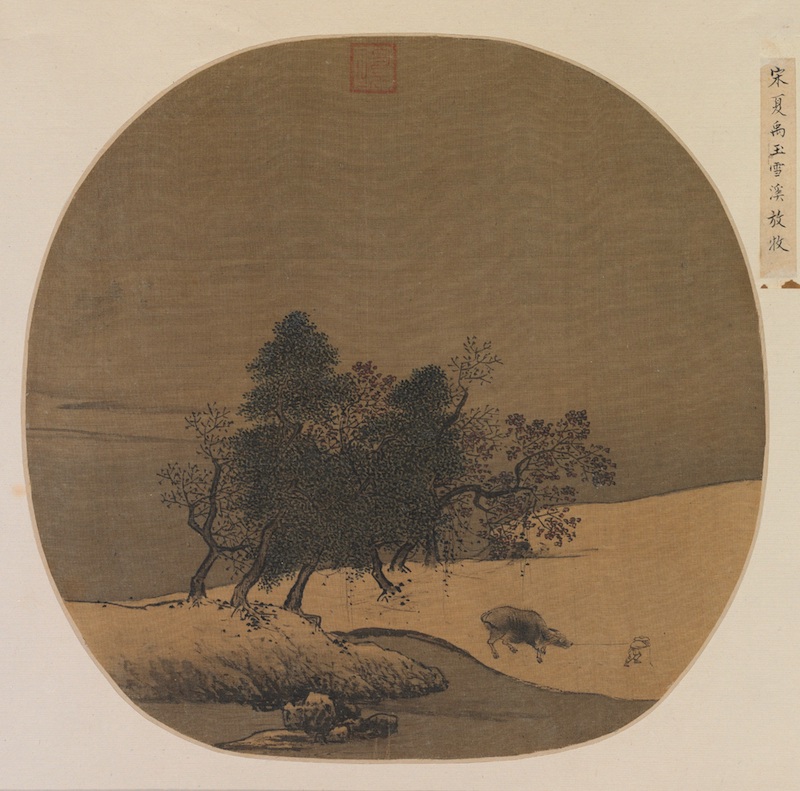
Southern Song Dynasty, Xia Gui, "Grazing in the Snow Stream", page, ink and color on silk
This page is selected from the fourth opening of the second volume of the "Song and Yuan Collection". It depicts the scene of farmers grazing in the snow, using silk as the snow, rendering the sky and streams in light colors, and a few old trees on the shore of the stone edge. The farmer and the oxen were simply drawn with a fine pen, but they were already struggling.
Xia Gui (birth and death unknown), first known as Gui, courtesy name Yuyu, was a native of Hangzhou, Zhejiang. In the Southern Song Dynasty, Ningzong (1195-1224) served as an edict for the painting academy and gave him a gold belt. He was as famous as Ma Yuan, and was called "Ma Xia" by the world. Learning from the Northern Song Dynasty to the Southern Song Dynasty, Li Tang has changed, making good use of ink techniques, and the strokes are ancient and the ink is dripping. Xuejing learned from Fan Kuan in the Northern Song Dynasty. The composition of the picture is often taken from the bottom of the picture, which is called "Xia Banbian", and the Southern Song Academy of Painting is unparalleled since Li Tang.
5. Li Song, Southern Song Dynasty, Volume of "The Merchant" 
Southern Song Dynasty Li Song's "Trademan" scroll and coloring on silk
Merchandisers are mobile vendors selling daily groceries, food, etc. along the streets in rural and urban areas, and they are the product of the development of commodity economy. This economic activity is depicted in the "Huolang Tu" that appeared in the Northern Song Dynasty. This work depicts the scene where the mother brings her cheering children to the village when she comes to the village, which is full of rich life flavor. From the words on the shelves, it can be seen that the merchant is also a Feng Shui master, writing documents, and reciting immortal scriptures. The painter outlines the outlines with fine brushes and applies light colors. The children's demeanor is innocent, and the joy and urgency are vividly on the paper. There are many items on the shelves, but the brushstrokes are not messy, which reflects the painter's superb skills.
The author's inscription "Jiading Xinwei Li Congshun's Male Song Painting", that is, this picture was painted in 1211. This piece has a poem inscribed by Emperor Qianlong of the Qing Emperor Gaozong: "It is exhausting to carry heavy burdens on your shoulders, and rob children of labor and support. Don't laugh at how idiots are, who in the world are not as idiotic. Guisi Zhongchun's imperial inscription." 銤 "Shiqubao "Gu" and "Yu Shufang Jian Treasures" and other seals of the imperial conservatories.
Li Song (1166-1243), a native of Hangzhou, Zhejiang. The adopted son of Li Congxun, a painter in the painting academy, was waiting for an imperial edict for the painting academy in the Southern Song Dynasty. He is good at painting folk customs, figures, and Taoism, especially in fine circle painting.
6. Song Dynasty "A Hundred Sons Playing in Spring" page 
Song Dynasty "A Hundred Sons Playing in Spring" page and coloring on silk
Infant play pictures are based on the theme of children's play, focusing on expressing their innocence, which is an important content of ancient genre paintings. Most of the paintings convey a relaxed and festive atmosphere. The pictures are vivid and the shapes are interesting. They can be combined with images of zodiac pictures and auspicious objects, implying that many children are blessed, and the children are continuous, giving people good expectations.
This picture is selected from the fourth book of "Selected Plants of the Four Dynasties: Heng Book". There are many playful scenes for young children, including imitating the activities of adults studying ancient times, talking by hand, and worshipping Buddha, as well as entertainment activities such as climbing sticks, flying kites, and puppet shows.
To the imperial title of Emperor Qianlong, Emperor Gaozong of the Qing Dynasty: "The style of the spring garden is harmonious with the haze theater, and the general Guizhang with the head and corners. Ask him where the powder came from, it should be in the fifth chapter of "Lu Lun". Seals such as "The Treasure of the Eight Expeditions" and "The Treasure of the Supreme Emperor".
7. Yuan Ren's "Dragon Boat Winning the Championship" volume 
Yuan Ren's "Dragon Boat Winning the Bid" scroll and ink pen
According to legend, dragon boat racing is related to Qu Yuan, or originated from ancient customs in Wuyue and other places. It was a very popular water splash activity in ancient times. The former site of Jinming Pond is located in Kaifeng, Henan Province. It was excavated in the Later Zhou Dynasty. It was renovated on a large scale in the second year of Taiping Xingguo (977) in the Northern Song Dynasty. It was the Royal Pool Garden in the Northern Song Dynasty. The emperor often taught the navy here, held dragon boat winning bids, banquets and other activities. From March 1st to April 8th of the lunar calendar every year, Jinming Pool and Qionglin Garden are open, allowing visitors to come and go freely.
This picture depicts the scene where the court of the Northern Song Dynasty held the dragon boat to win the bid in Jinming Pond, which is the epitome of water play in the Song and Yuan Dynasties. The palace of the Northern Song Dynasty generally held dragon boat water play activities in March, which is described in more detail in "Tokyo Menghualu". The boundary paintings in the picture are neat and pure, showing the magnificence of the palace garden and the dragon boat. In addition, there are games such as water swings, and there are small dragon boats, flying fish boats, and loach boats in the pool. Although the figures in the picture are small, they are numerous, with various forms and movements, such as racing, juggling in the water, performing music, or standing. The details are rich and sufficient for research.
8. Ming Zhou Chen's "Xia Qi Shi Ze Tu" page 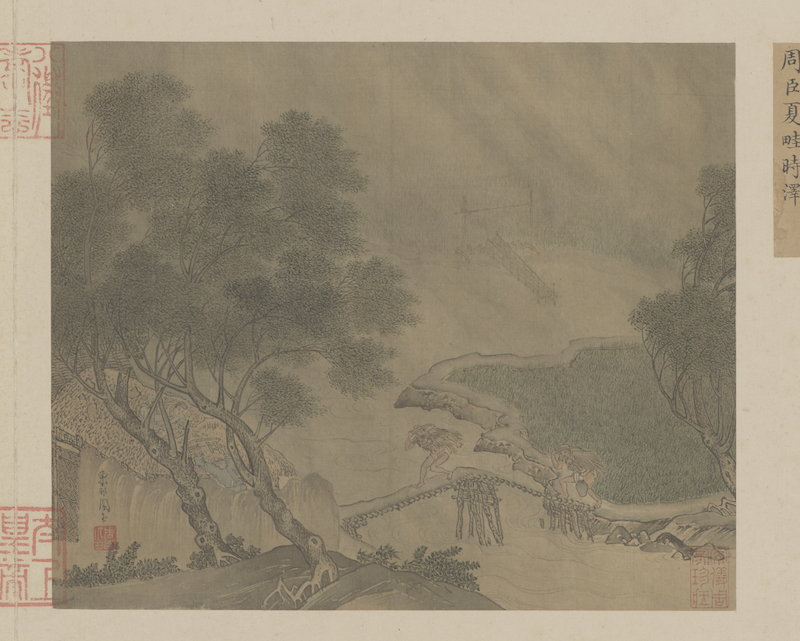
8. Ming Zhou Chen's "Xia Qi Shi Ze Tu" page and coloring on silk
This is selected from the eighth opening of "The Selected Algae of the Four Dynasties: The Book of Zhen", which shows the scene of the heavy rain falling suddenly in summer and the farmer returning home in a hurry. In the picture, the lines of the characters are concise, but the modalities are vivid. The rocks on the bank of the bank are split with an ax, and the brush is vigorous. The leaves of the border fields are drawn in detail, and the setting is empty, making the viewer feel like they are in a misty rain. On the lower left of the picture is the author's inscription "Zhou Chen in the East Village" and the seal "Zhou Chen Yin" in white.
The imperial inscription to Emperor Gaozong of the Qing Dynasty: "It was sunny and dry on the fifth day of the summer border, and the scenery of Zedong Village was in sight. Leak-proofing is more urgent than riding a house, and I prefer to buy a car to see it. The trees are far away from the beach. There are still those who have complaints and counsels who are not at ease, so you should know the difficulties early on.”
Zhou Chen (birth and death unknown), courtesy name Shunqing, number Dongcun, was born in Suzhou, Jiangsu. Good at figures and landscapes, he was a professional painter active in the early period of Ming Zhengde (1506-1521) and Jiajing (1522-1566). His brush and ink are based on Li Tang and Ma Yuan in the Southern Song Dynasty, and he was also taught by Dai Jin in the Ming Dynasty. Tang Yin and Qiu Ying in "Four Families of Wumen" both went out.
9. Ming Zhang Ling's "Fishing Music" axis 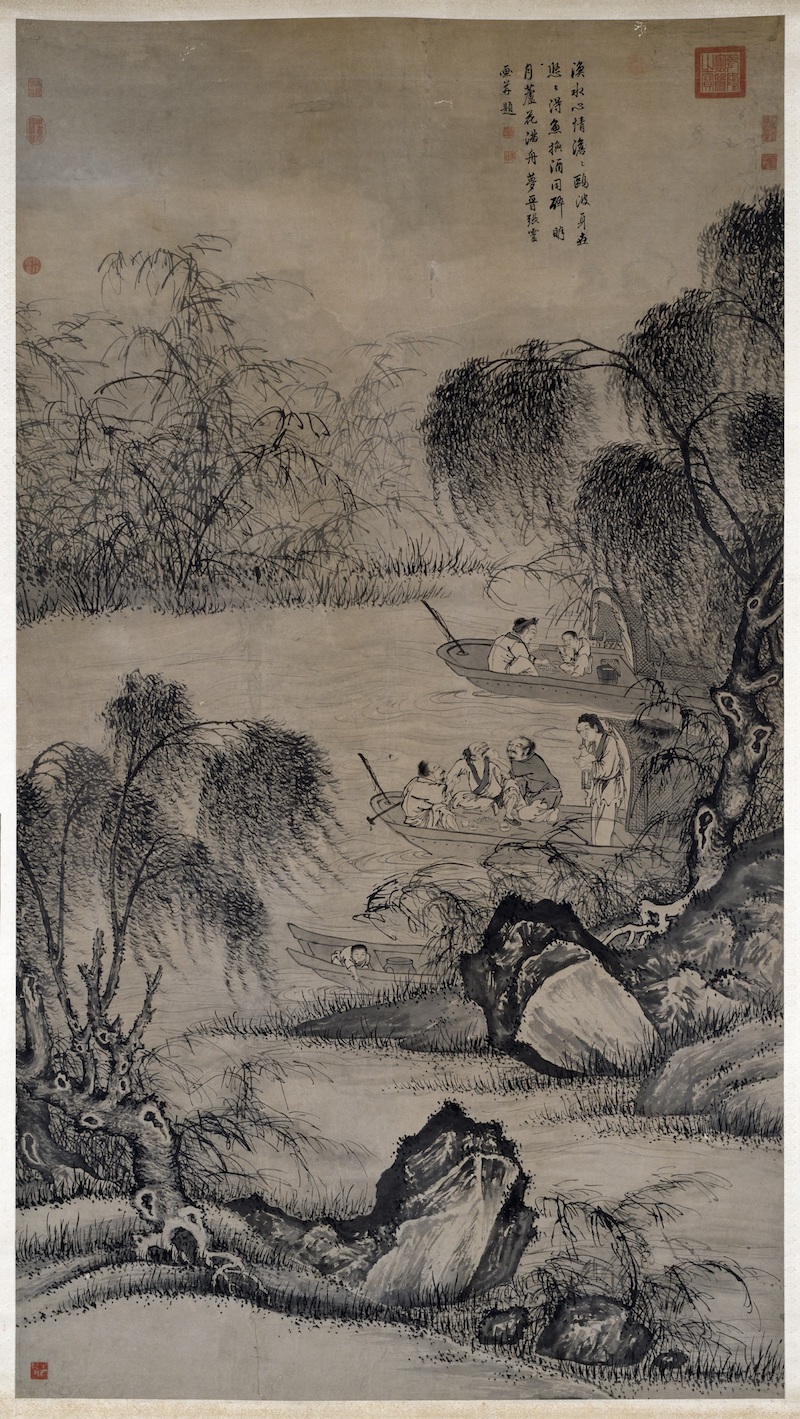
Ming Zhang Ling's "Fishing Music" scroll, ink and pen on paper
The picture depicts the scene of the fisherman Xia Jing drinking in his spare time. The boat is on the edge of the water, the willow leaves are light, and the fishermen gather to drink for pleasure, and the life is full of interest. The figures are simple in clothing patterns, clear and expressive in their eyebrows and eyes. The mountains and rocks are "smashed with an axe".
The author wrote by himself: "The mood of fishing water is dreadful, and Ou Bo has a long life. Get fish for wine and get drunk, and the moon is full of reeds and flowers. Dream Jin and Zhang Ling's paintings are inscribed together." The seals are "Zhang Lingzhi" and "Dream Jin". This picture was collected by the Qing Dynasty, with seals such as "Shiqu Baoji", "Sanxitang Jingjianxi" and "Yushufangjian Treasure".
Zhang Ling (active from the second half of the fifteenth century to the beginning of the sixteenth century), courtesy name Mengjin, was a native of Suzhou, Jiangsu. Mr. Zhang was a famous scholar in Wuzhong, from a poor family. He was not well-known in his early years. He was unruly, addicted to alcohol and wild. Under the tutelage of Zhu Yunming, he was a neighbor and friendly to Tang Yin. He and Tang Yin once pretended to be a beggar in the snow and sang "Lotus Falling", and they drank wine with the money they earned. Zhang Lingshan is good at bamboo, stones, flowers and birds, and the figures in the paintings are ancient and clumsy.
Note: The exhibition will be on display in the Wenhua Palace until October 30, and it is free to visit with tickets to the Forbidden City, but reservations are required.
